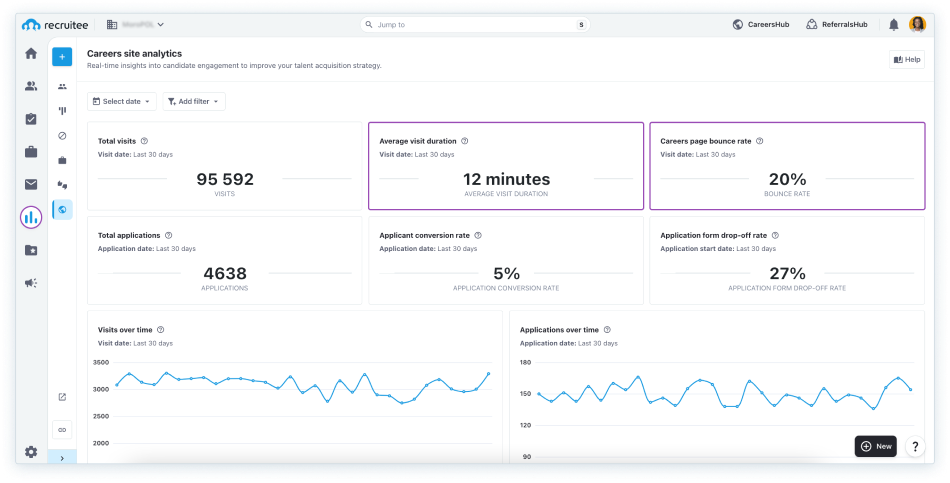The recruitment—and business—landscape is in a continuous state of change. Skill demands evolve, workforce demographics change, and the recruitment techniques that HR teams use must adapt to keep pace.
Recruitment is a game of tradition and experimentation. There are tried and tested techniques that remain a staple in virtually all hiring processes. And there are new and innovative techniques that allow recruiters to stand out from the competition, and leverage new technologies to their advantage. The trick is in keeping up with all of this change.
This article walks through 20 recruitment techniques that you should consider today, and into the future. It offers insights into how these techniques can benefit your recruitment, and what the impact will be for your organization.
Let’s dive in.
The recruitment landscape today
Today’s recruitment landscape is a challenge, to say the least. Despite a flood of talent entering the market due to the mass tech layoffs in 2022 and 2023, there remains tight competition for in-demand skill sets.
Recruitment in 2024 and beyond is defined by a combination of technological advances in the form of AI and automation, along with ongoing demographic shifts that cause major skill gaps and institutional knowledge retention issues. Outside economic factors, meanwhile, have constrained budgets, requiring organizations to become more agile and tactical with their recruitment efforts. There’s continued tension over return-to-work-mandates (RTO), along with ongoing considerations related to DEI and social governance.
To meet these challenges, recruiters and organizations need to—and have—adopted a range of techniques and strategies to help them improve the efficiency of their hiring practices, attract top-tier talent, and leverage modern tools to improve results.
20 recruitment techniques for 2025 (and beyond)
Here are some of the most impactful recruitment techniques that organizations should consider in 2025 and beyond. Some of these are traditional and timeless, while others relate to modern trends in recruitment technology and external market forces.
1. Develop a company culture that attracts top talent
The first, and perhaps most importantly, traditional recruiting technique you should invest in is creating and nurturing a positive company culture that people want to be a part of.
Spending time and resources on attracting the best talent means little if your company culture falls short of your employees’ expectations.
While company culture isn’t usually thought of as a ‘recruitment technique’, having a strong company identity goes a long way in pitching yourself to candidates. If you’re a company that’s lucky enough to have a strong culture already, then be sure to promote that fact throughout your recruitment strategy.
If your company culture is a weak point, then consider ways in which you can work with people throughout your organization to improve this critical business element.
2. Build a strong employer brand
Closely related to your company culture is your employer brand. This is how you promote your company culture, and entice high quality talent to apply to your open roles.
With the increasing popularity of employer review websites like Glassdoor, and the tendency for candidates to review a company’s reputation and culture before applying, employer branding is quickly becoming a popular recruitment method.
The goal here is to clearly position your company as a great place to work. This can be accomplished using a customized career section, employee testimonials, and profiles, an active Glassdoor or Instagram page that provides insights into what it’s like to work for you, and any other technique you can think of to put your best foot forward.
Creating and managing your employer brand will help show candidates why they want to work for you before they even sit down for an interview.
3. Recruitment and develop talent internally
Recruitment is typically thought of as an external exercise, but perhaps the best way to guarantee you find the right person for a role is to promote someone from within your organization.
Hiring internally is a valuable recruitment strategy because it guarantees that you’re filling vacant positions with people who already understand your company, its culture and what is expected of them. Additionally, recruiting internally shows employees throughout your organization that you’re committed to their progression and growth.
A strong talent management program that focuses on development, succession planning, and upward movement is a great way to show employees and candidates that there’s a future for them at the company.
4. Launch (and modernize) your employee referral program
Employee referral programs are a common recruiting technique in many companies and are a powerful way to harness your colleague’s industry contacts. These programs encourage employees to help fill vacant positions at the company by recommending qualified candidates and vouching for their skills and experience.
This can drastically speed up the screening process of vacant roles and allows you to tap into candidate pools you may not otherwise have accessed.
A referral program should offer incentives and recognition for successful hires. Typically, the human resources department will put together a short document, shared internally, that clearly explains how the referral program works, what employees get out of it, and how to get started.
Finding ways to modernize traditional employee referral programs should also be a priority this year and beyond. Integrating gamification and social media networks into the mix can make it easier for employees to tap into their networks and recommend top-tier talent.
5. Reform your interview process
Interviewing candidates is perhaps the most widely used and, often, the most poorly executed recruitment method. It’s so common, in fact, that many recruiters may rarely give a second thought to their list of canned interview questions.
But, as most modern recruiters know, reading a generic list of questions to every single candidate simply does not allow you to get a full picture of your potential hire. It also creates a terrible experience for your applicants.
If you haven’t done so already, take a look at your interviewing process and ask yourself a few questions: Do you spend the time needed to get to know your candidates? Are you asking the right questions to help make your decision? Are you tailoring your interview questions for each position?
If the answer to these questions is “no,” then it might be time to reform your interviewing process.
The interviewing stage is also a good place in the recruitment process to leverage AI-based analytics and automations. Video interviewing platforms, for example, can often analyze recorded video interviews and offer insights into candidate responses. These insights can then be used to help recruitment teams objectively assess interview performance and culture fit.
6. Lean into data-driven recruitment
As companies increasingly adopt different technology platforms to help streamline their hiring processes, data-driven recruitment will help drive smarter strategies for finding and screening candidates. These platforms allow recruiters to manage candidate data securely, ad platforms, screening practices, onboarding, and talent management.
Companies should take a deep dive in their recruitment data and help them find insights into how they can adapt, improve and streamline their recruitment strategy going forward. For teams looking to adapt and thrive in the future, this is a top recruitment method to embrace and add to your recruitment strategy plan.
If you're using Recruitee by Tellent, be sure to utilize our Careers site analytics, which offers a robust set of data about your careers site, including total visits, average visit duration, bounce rate, application conversion rate, application form drop-off rate, and most visited jobs.

With this data, recruiters and marketers are able answer critical questions about their careers site, and craft strategies to boost performance.
Tip:
Tip:
See how you can optimize your careers site to get more candidates with Recruitee's careers site analytics.
7. Create interactive and engaging job content
To support employer branding, job postings, and recruitment marketing, companies should consider investing in engaging and interactive job content. Leveraging video marketing is an excellent way to showcase your company culture and what it’s like to work in specific departments or teams.
For example, you could use video job descriptions and behind-the-scenes content to make job postings stand out and give candidates a real sense of their company culture before they apply. This content can then be shared across social media channels, job postings, and your website to create buzz and excitement about the role.

8. Invest in AI recruitment tools
AI has taken off in a big way in the recruitment world—and well beyond it—helps companies find efficiencies in their process, insights from their people and candidate data, and facilitating automation across the hiring cycle.
For example, AI is actively used in many modern ATS platforms to review cover letters and CVs, helping to shortlist high-potential candidates quickly. But while AI can certainly speed up processing times in applicant shortlisting, it should never be a complete replacement for human reviews and judgment. Recruiters should still find ways to balance efficiency with human intervention to ensure that high-potential candidates with unorthodox resumes don’t fall through the cracks.
Generative AI is also being used to write or analyze job descriptions to ensure they’re free of biased language. And AI chatbots and email automations are actively being used to interact with candidates, answer questions, schedule interview times, and so on.
Recruitee's AI job description writing tool, for example, uses natural language processing (NLP) to draft engaging, easy-to-read job descriptions for your candidate in minutes. Like with using AI for shortlisting candidates, however, you should always personally review the output from this writing tool.

AI still has a long way to go before it can operate independently. Consider it, and other tools like it, as a way to get started. You still need to use your expertise and creativity to ensure top quality for your job descriptions and hiring decisions.
9. Incorporate employee testimonials into your positioning
Another opportunity to improve employer branding is through the use of employee testimonials throughout your recruitment content. For example, you can include testimonial quotes and videos in your job posting, on your career site, in your application portal, and even throughout the interview process.
This goes a long way to helping candidates understand what it’s actually like to work at the company, and whether or not it’s a fit for them.
Here’s an example of how Miro incorporates employee testimonials onto their careers page to add a bit of social proof to their employer narrative.

10. Use skills-based assessment techniques
There’s a trend in recruitment that’s moving away from sole emphasis on resumes and formal education or experience in-favor of skills-based hiring. That is—the emphasis is placed on whether or not a candidate has the skills to do well on the job, rather than if they have a defined set of credentials.
To do so, companies should adopt skills-based assessment techniques to help them test real-world abilities. These assessments can take place at any stage in the hiring process, and can be automated using AI technologies.
For example, Jess Munday from Custom Neon, says that her team has begun using AI-based screening tools during the application phases to test basic skills requirements. This, she says, has reduced their time-to-hire by ensuring only qualified candidates make it through to the interview stage and, as a result, has improved their quality of hire.
Harrison Tang from Spokeo, likewise, credits a skills-based approach to screening—rather than one that focuses on experience or education background—helps them align the candidates’ abilities more directly with the job requirements. This, he says, leads to better and more efficient hiring experiences, saving the company hundreds of hours per hire.
11. Focus on a mobile-first recruitment strategy
With the majority of Millennials and Gen Z already in the workforce, a mobile-first recruitment strategy should be at the top of your list of priorities. The newer generation of job applicants expect that your candidate experience will be a mobile-friendly one.
From the job advertisement to the application portal and all the way to the end of the screening process, you should ensure that candidates are able to complete each step easily on a mobile device.
12. Ensure you’re a remote-friendly workplace
According to Forbes, roughly one-fifth of the workforce is now remote, with a staggering 98% of workers wanting to work remotely at least some of the time. The cat’s been out of the bag for remote work since the start of the pandemic, and it’s likely not going to go back in any time soon.
To adapt, companies need to start thinking about how to appeal to remote workers. Afterall, this greatly increases the number and quality of potential applications by widening the net from local recruitment to global. With this, however, comes the need to think like a remote company, and offer an environment that is remote worker-friendly.
Dan Pankaew from Listening.com says that his companies began offering remote work perks in their job ads, including flexible hours and remote worker allowances to help them attract candidates who prioritize work-life balance.
As a result, Pankaew says his company saw a 20% bump in remote job applications.
13. Offer micro-internships and job test
Job tests have long been a staple recruitment technique for many companies. This is where hiring managers ask the candidate to complete a task that’s similar to what they would be asked to do in the role.
Micro-internships take this concept a step further. They offer candidates short-term projects—either on location or virtually embedded into the team. The candidate gets to demonstrate their skills and abilities in a real-world environment, and the potential employer gets to gauge how well that candidate performs alongside their future teammates.
Mark Pierce from Wyoming Trust explains that they regularly use micro-internships to see how candidates handle real work. “By giving them a test of the real thing,” he explains, “we get a better sense of who could actually thrive in our environment.
As a result of this program, Pierce says that the company has seen a 30% increase in intern-to-hire rate, and stronger long-term retention from new hires.
Micro-internships should be paid, of course, as candidates will be completing real work for your company.
14. Level-up your strategic recruitment marketing
Like employer branding, recruitment marketing is a technique that’s designed to strategically position and advertise your company in the most efficient way possible. Recruitment marketing refers to a variety of strategies that an organization uses to find, attract, and nurture prospects before they apply for a job.
The most common recruitment marketing techniques include creating targeted audience profiles, customized content and marketing materials, a careers website, job advertising, social media, candidate lead capturing and nurturing, and data collection.
Taken as a whole, these recruiting techniques help create a measurable candidate funnel that you can harness to fill your vacant positions.
15. Adopt video interviewing and screening
Video interviewing is a great recruiting technique to improve your candidate experience and eliminate geographic constraints. The old tradition of dragging every candidate into the office is a little bit archaic when you consider the quality of video conferencing and interviewing platforms on the market today.
In addition to formal interviews using video chat, you can also ask candidates to submit video cover letters, CVs, or pre-screening tests using a feature like Video Answers. This lets you get a feel for the candidate’s personality in a much more efficient way than in-person talks and allows you to interview candidates from anywhere in the world.
16. Invest in an Applicant Tracking System (ATS)
While the recruitment methods listed so far certainly help to improve the quality and reliability of your hiring, they aren’t easy to pull off at scale. Companies need a reliable platform at the center of their recruitment department to help intake, process, and action data across all stages of the hiring lifecycle.
An Applicant Tracking System (ATS) isn’t just a program, it’s a strategic necessity for hiring teams in 2024 and beyond. Many companies struggle with the same pain points–a lack of oversight throughout the recruitment process, insufficient applicant flow, poor candidate experience, and challenges collaborating amongst hiring team members.
An ATS and collaborative recruitment platform like Recruitee helps to solve these challenges. It provides a centralized database for candidate data and profiles, enabling better access to critical information and applicant files. Modern ATS platforms also automate tedious tasks, centralize workflows, and enable better collaboration through integrated communication tools like comments, candidate ratings, and chats.
Recruitee, as an example, also offers robust reporting features, allowing companies to make data-driven decisions, improve their hiring process, and ensure compliance with regulations like GDPR.
By investing in an ATS like Recruitee, organizations can streamline their recruitment efforts, attract higher quality candidates, and reduce time-to-fill, ultimately leading to a more efficient and effective hiring process.
17. Launch a collaborative hiring process
Considered one of the more modern recruitment techniques, collaborative hiring is a process that brings additional members of your operation into the recruiting system, usually during the interview process but not exclusively.
Collaborative hiring has proven to benefit hirers with the best cultural fits, reducing the stress of recruiting and providing candidates with their prime candidate experience. As well as speeding up the recruiting process, it provides better-fitting and strong hires, boosting employee retention and saving money long-term.
18. Focus on social media recruiting
Social media recruiting can provide great results in tracking down candidates when carried out correctly—especially now that Gen Z and Millenials make up such a large percentage of the workforce.
Although hiring through social media isn’t anything new, it’s still a powerful way to reach candidates. With so many users, so many platforms, and so many methods to reach out, SM recruiting techniques are often free or hold incredibly good value; hirers would be remiss to fail to include them as part of their process.
Depending on your brand, some platforms will work better to find your ideal hire than others. Don’t count out any less conventional platforms either, as there are plenty of opportunities in places you might not have considered.
Have you tried Tinder or any of the dating apps to spread your reach? If your market is less mainstream or youthful, do your hires fit into the demographics you’ll find on Snapchat or TikTok? Just because you haven’t tried them yet, doesn’t mean it won’t work for you.
19. Find niche job boards
Recruiters often attend niche industry events to find specialists within a specific field or industry. This is a tried and tested recruitment technique that can be replicated online by finding job boards, communities, and other virtual “hangouts” for your target candidates.
We’ve put together a guide to get you started with some of the best job boards we know of, including a range of niche websites for in-demand and diverse talent.
20. Test your own guerrilla recruiting
The last recruitment technique to consider adopting is guerilla recruiting. Or, putting your guerrilla marketing hat on and thinking of radical ways to connect with qualified candidates and beat the tight competition.
This can include finding places in real life or on the web where your candidates gather and marketing your roles directly to them in unexpected and creative ways.
Always be experimenting with new recruitment techniques
Change is the only constant in business, and that’s especially true in recruitment. Demographics, internal and external forces, market changes, and economic ebbs and flows all converge to impact the types of candidates that are available at any given time, and how you appeal to them.
Experimentation with existing and new recruitment techniques is a must. This is how you stay on top of new trends, and stress test existing strategies to ensure that they’re still effective.
Be creative, and don’t be afraid to think outside of the box when it comes to changing up your recruitment methods.
Look at your selection strategies and recruitment processes critically using data to objectively identify the tactics that are working well, and those that aren’t. And look beyond your own environment; innovative recruitment methods may be sitting right under your nose.
Standing out from the rest of the crowd will go a long way to securing the best talent!

Tellent Recruitee Newsletter
Sign up for our newsletter and get practical hiring advice, fresh recruiting ideas, and product updates you’ll actually want to read.

.jpg?width=1600&name=66dad3650c3628c4aac87a68_top-view-of-note-with-light-bulb-drawing-and-crump-2021-08-31-14-50-01-utc%20(3).jpg)


.jpg?width=1000&name=6797cc6580ed37f294dde1be_pexels-linkedin-sales-navigator-7245806%20(1).jpg)


